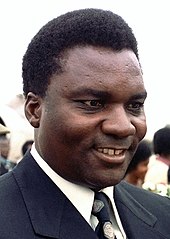| 1973 Rwandan coup d'état | |||||||
|---|---|---|---|---|---|---|---|
 A CIA WFB map of Rwanda | |||||||
| |||||||
| Belligerents | |||||||
| Committee for Peace and National Union | Rwandan government | ||||||
| Commanders and leaders | |||||||
| Juvénal Habyarimana | Grégoire Kayibanda | ||||||
| Units involved | |||||||
| Rwandan Armed Forces | None | ||||||
| Casualties and losses | |||||||
| 0 | 56 died after arrest | ||||||
| Part of a series on the | ||||||||||||||||||||||||||||
|---|---|---|---|---|---|---|---|---|---|---|---|---|---|---|---|---|---|---|---|---|---|---|---|---|---|---|---|---|
| History of Rwanda | ||||||||||||||||||||||||||||
   | ||||||||||||||||||||||||||||
|
||||||||||||||||||||||||||||
The 1973 Rwandan coup d'état, also known as the Coup d'état of 5 July (French: Coup d'état du 5 Juillet), was a military coup staged by Juvénal Habyarimana against incumbent president Grégoire Kayibanda in the Republic of Rwanda. The coup took place on 5 July 1973 and was considered by many as a betrayal.
Background
While still under Belgian rule in the 1950s and early 1960s, resentment towards colonial rule and the ethnic Tutsi elite among the Hutu had increased, and led to the formation of the political party Parmehutu by Grégoire Kayibanda in 1957, with aims to overthrow the monarchy and gain identical rights ("emancipation") for the Hutus. This was achieved following the 1961 election and referendum, but the absence of effective Tutsi opposition led to regional tensions between Hutu politicians. The central and southern politicians were opposed by those from the north.
In the months prior to Habyarimana's coup, the Army (mainly composed of northern soldiers) had intensified persecution of ethnic Tutsi through the formation of Hutu vigilante committees to ensure enforcement of the required ethnic quotas requested by Habyarimana. Kayibanda refused this policy of quotas and was then described by the Army as a 'weak' leader. Fake rumors and documents were produced by the Army against the President and Rwanda became isolated economically and diplomatically, especially from neighbouring Uganda (then under the rule of Idi Amin) which housed large numbers of Tutsi. This situation was regarded by the majority of the population as a betrayal from Habyarimana. Indeed, prior to the coup Habyarimana, who served as Army Chief of Staff, was also a friend of president Kayibanda.
The coup d'état
On the morning of 5 July 1973, Juvénal Habyarimana with AML-60 armored cars and infantry from the Rwandan National guard, took over the government and put then-president Grégoire Kayibanda under house arrest. The next morning after the coup Habyarimana announced the Committee for Peace and National Union. The coup was completely successful and resulted in no lives lost; however, 56 people were arrested. After the coup, all 56 people that were arrested, including former president Grégoire Kayibanda, starved to death while in prison.
Aftermath

Immediately after seizing power, Habyarimana established a totalitarian dictatorship and outlawed all political parties, but in 1974 created his own, the National Revolutionary Movement for Development (Mouvement révolutionnaire national pour le développement, MRND), as the country's only legally-allowed party.
While the coup itself was bloodless, fifty-six people – mostly former leaders – were killed by the security services between 1974 and 1977, with Kayibanda dying in detention in 1976, probably of starvation.
Notes
- ^ Prunier 1998, p. 61.
- Rwanda at the Encyclopædia Britannica
- Prunier 1998, p. 75; 60.
- The Rwandan Patriotic Front. Helion & Company Limited. 2015. pp. 10, 11. ISBN 9781910294567. Retrieved 29 March 2022.
- Verwimp, Philip (2006). "Peasant Ideology and Genocide in Rwanda Under Habyarimana" (PDF). In Cook, Susan E. (ed.). Genocide in Cambodia and Rwanda. p. 8. ISBN 9780203790847.
- Prunier 1998, p. 76.
- "Mission d'information sur le Rwanda" (in French).
Celui-ci s'était construit sur la destruction de la Première République. Entre 1974 et 1977, 56 personnes, pour la plupart d'anciens dirigeants de la Première République, avaient été assassinés par les services de la sécurité. Le premier Président rwandais, Grégoire Kayibanda, était mort en détention en 1976, probablement de faim.
References
- Prunier, Gérard (1998), The Rwanda Crisis, 1959-1994, London: Hurst & Co., ISBN 9781850653721
External links
| Years in Rwanda (1962–present) | |
|---|---|
|